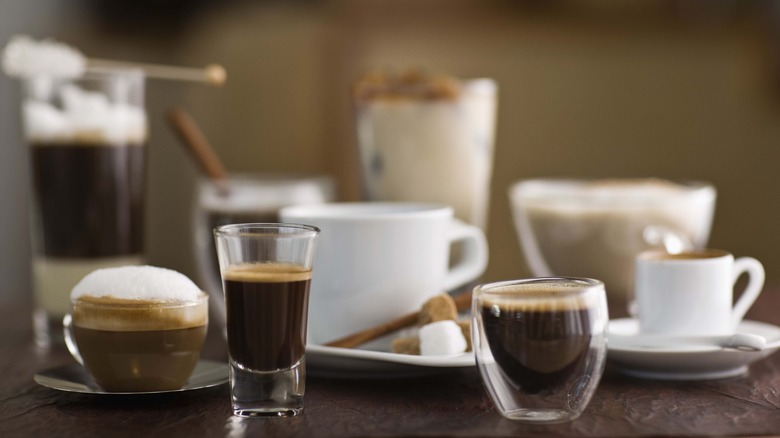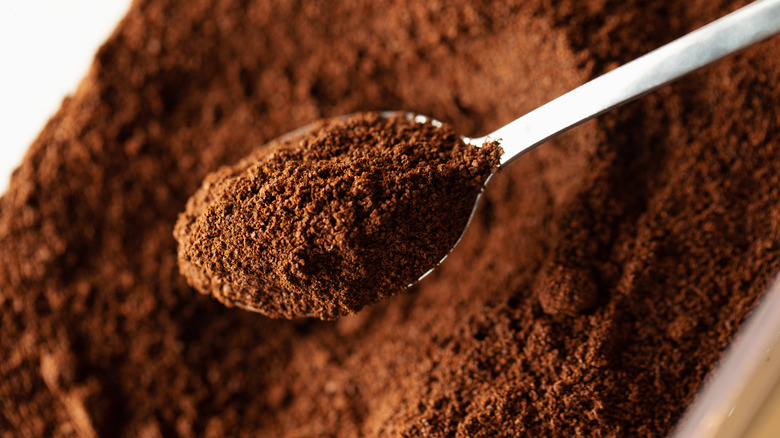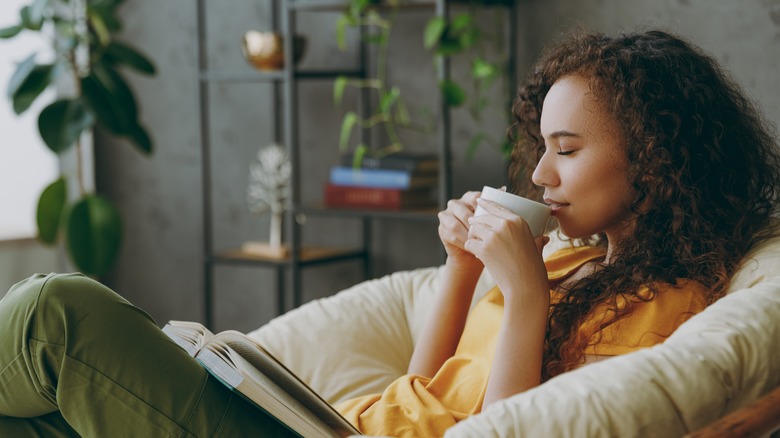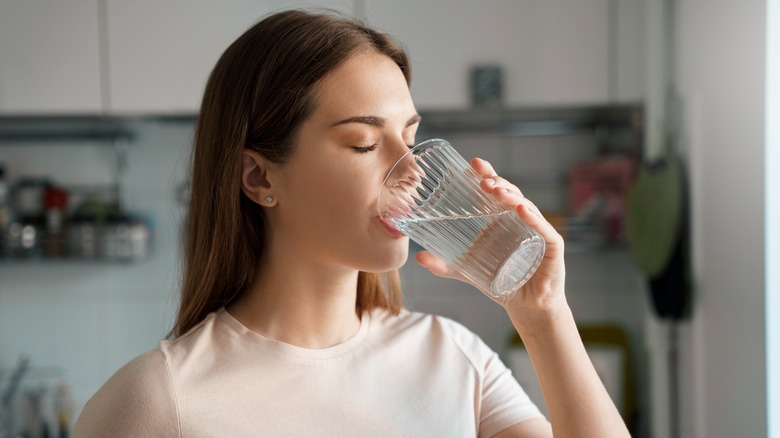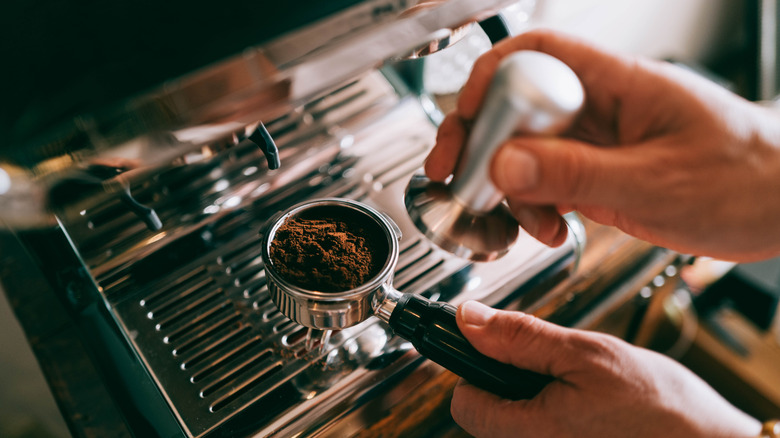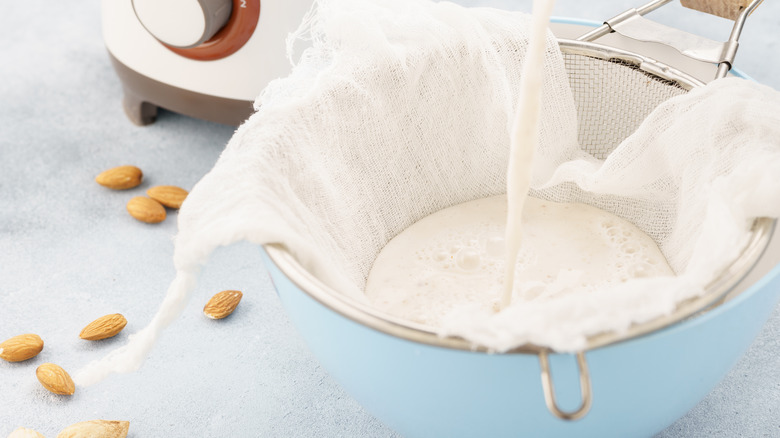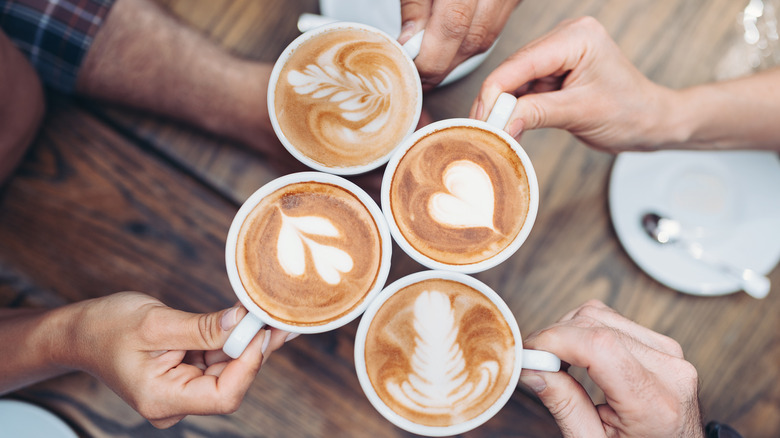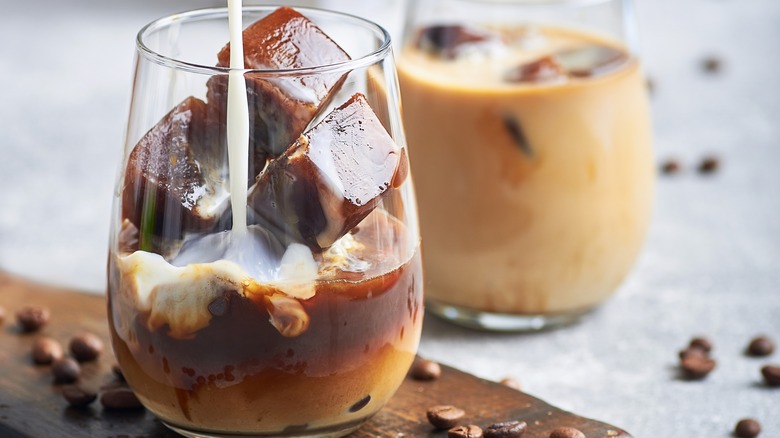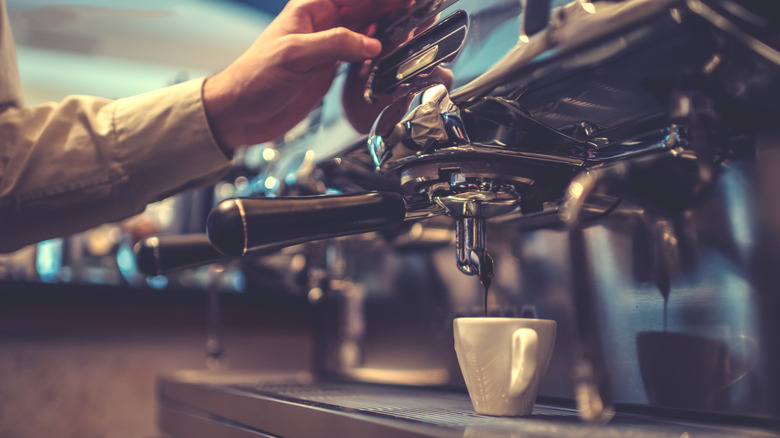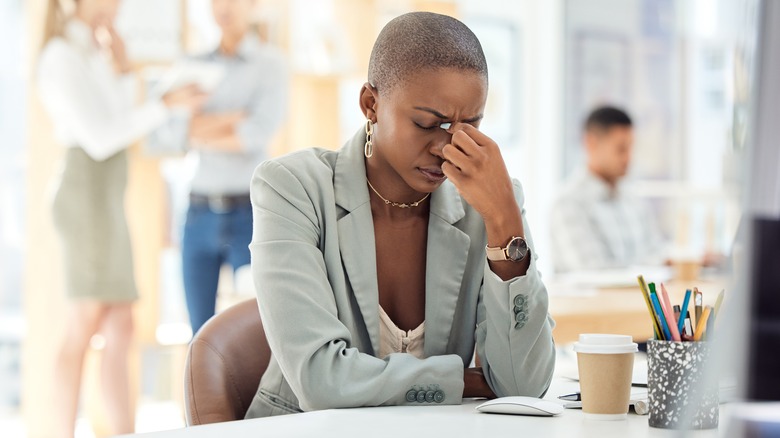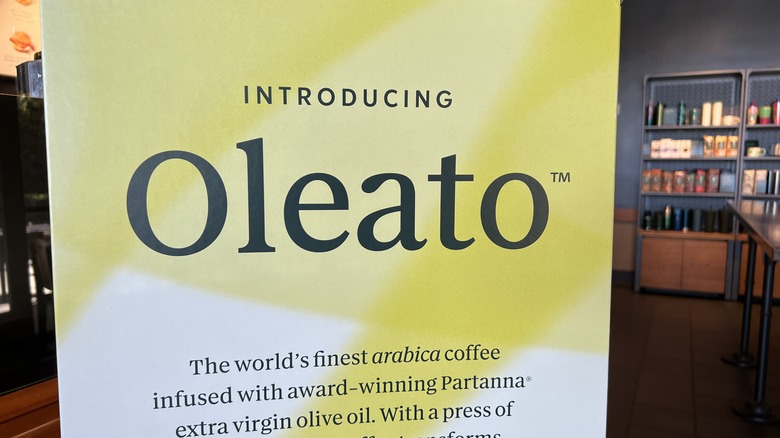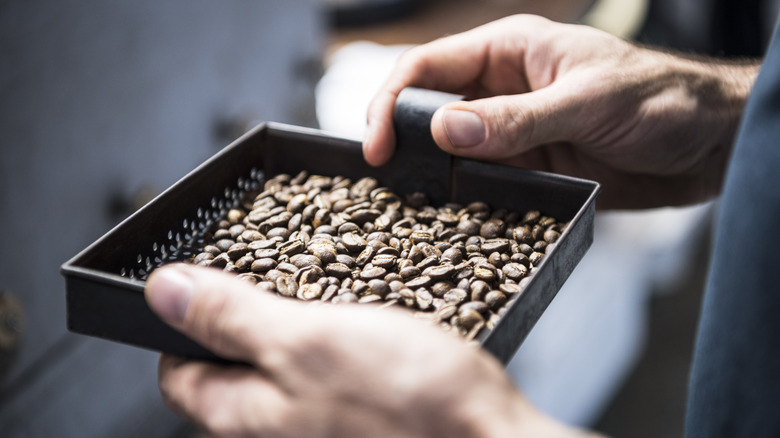12 Coffee Myths You Can Stop Believing
Do you love a nice warm cup of coffee, perhaps with a sprinkle of cinnamon and a dash of milk, but avoid drinking it because of some perceived side effects? Perhaps it's time to set the record straight, breaking down truths and rumors about common coffee myths too often mistaken for the truth. Because misinformation makes matters murky, and there are few things worse than a clouded cup of coffee.
Aside from coffee's supposed side effects, there are additional misconceptions about dark roast versus light, the perceived stigma of instant brands, and whether or not one coffee variety is truly "the best." In such matters, knowledge is power.
Whether you're an avid coffee drinker, or just an occasional one, it's important to know what's really going on inside your cup of joe. In order to gain some insight, we spoke with recipe developer/home barista Farhan Maqsood (known on Instagram as @coffeebro0) about what he has brewing, both in his cup and on his mind.
Instant espresso is worse than other kinds of coffee
If you've been thinking of instant coffee all this time as a last resort, it might be time to re-evaluate such a mindset. Instant is more than just a camping and road trip staple, employed by those far away from their home espresso machine.
"I have no shame to tell people to drink instant coffee," Farhan explains. "Why? Because it is so accessible."
Farhan makes a fair point. Instant coffee can be turned into so much, from a regular cup of hot java to the viral Dalgona coffee that swept across the internet a few years ago. It has great potential, and if you are just starting out on your coffee journey, it's a solid place to start. Instant coffee is usually cheap, easy to find in the grocery store, and can teach you the basics of what you enjoy about coffee. But even if you're a seasoned coffee pro who knows their way around a complex espresso machine, sometimes you don't feel like taking the time to make an entire latte from scratch. There are some pretty good quality instant coffee brands out there, too, that are worth your time.
Coffee gives you acne
You drink a cup of coffee, and then the next morning you wake up with a new friend on your cheek. Is your beloved iced vanilla latte doing this to you? Not necessarily.
"If you have a problem with acne, I think it is connected to the iced latte with whole milk. I think it's the milk, not the coffee," Farhan explains of possible connections.
This claim is backed up by a ton of research in the field maintaining that the coffee itself isn't necessarily causing acne — it comes down to what you put in your drink. "Coffee gives us energy. Coffee makes us happy. I think people should get aware of the myths, especially [with] acne," Farhan adds. He also notes that it's always a good idea to talk to a dermatologist about acne and your skin.
Caffeine in coffee can contribute to existing stress levels, which can then contribute to existing acne. The milk you use in your coffee, meanwhile, can affect your skin, depending on how sensitive your body is to it. So, try out different kinds of milk in your drink instead of just sticking to whole, and see how it goes for you. Additionally, the sugar in your drink can contribute to acne as well, so think before ordering your next cup.
Coffee makes you dehydrated
Does coffee make you dehydrated? In short, thank god, no.
The reason you've probably heard this misconception is because coffee is a mild diuretic, which means it can make you have to use the bathroom. The amount of caffeine in your drink can impact how much it flushes you out. Lower amounts of caffeine can even hydrate you, as your body absorbs the liquid in the drink. Higher amounts of caffeine are more likely to have an impact.
"Drink water before coffee and after," Farhan says to those concerned about dehydration.
Like many misconceptions, it typically comes down to the type of drink you get and how you're approaching coffee. Drinking it on an empty stomach at 7 p.m. will probably not make you feel too great, simply because caffeine on an empty stomach can be taxing. Approaching your coffee with consideration and care, however, will give you a better overall experience.
Espresso has more caffeine than regular coffee
When it comes down to semantics, ounce-per-ounce, espresso does technically have more caffeine than regular coffee. But most people do not drink equal measurements of each, so in some ways it's like comparing apples to ... well, much smaller apples. When you're debating between ordering a latte at a cafe or making a Keurig cup of coffee at home, if the deciding factor is which one has more caffeine to get you through the day, what you really need to calculate is a matter of equivalency, not equality.
Your at-home mug can probably hold around 12 ounces of coffee. At a coffee shop, a latte with a shot or two of espresso would typically come out to less caffeine, with cup size and the amount of milk you add offering additional variables. If you are really craving that latte but require an extra jolt, ask for either a bigger-sized latte or an extra shot added into it.
Coffee and orange juice don't mix
Most folks are accustomed to seeing OJ and coffee side-by-side at the breakfast table — not in the same glass. But Farhan insists that the two great tastes actually go great together.
"There's one coffee that people should try and people should love," Farhan notes. "[An] orange espresso tonic." If you haven't seen the plethora of TikToks and videos of people experimenting with this combination, and if have never seen it on the menu at a cafe, you might be unfamiliar with the intriguing combination of two breakfast staples. But espresso and orange juice do in fact mix very well.
"It is very controversial," Farhan adds. "I've done the video. I've gotten all the hate... but it is amazing... It has a zesty orange juice, an espresso shot, and soda water, and ice. It's so refreshing."
Worth noting is that with this recipe, it's going to taste better if you use a shot of espresso rather than a regular cup of coffee. This is because the ratios of each, and the concentration of the espresso flavor, ] balance better with the punch of citrus and carbonation of soda water (if you choose to add any). But if you even just want to enhance a mediocre cup of hotel coffee, adding a splash of orange juice can brighten the flavors and transform the drink. Don't knock it until you try it.
Nut milk can be made at home
We get it — the thought of making milk yourself at home sounds more like something they'd do in the 1800s than in the 21st century. But in reality, it can be quite rewarding. Farhan loves to make his almond milk at home instead of buying it from the grocery store, and he's kind enough to share his recipe. "It's very easy to soak and drain the almonds overnight," Farhan explains. "Then the next morning you put some dates and almonds and water. Blend in a blender, and then strain with a cheesecloth."
Once you've mastered the basics of the recipe, feel free to flavor the almond milk any way you'd like, either with vanilla, hazelnut, caramel, cinnamon, or whatever you desire. What's nice about making your own almond milk is that you can have precise control over the taste, allowing you to create that perfect almond milk latte you've been dreaming up. But this doesn't just apply to almonds — once you've got the basics down, it's easy to make milk out of any nut.
Coffee is bad for your overall health
Is coffee good for you? In moderation, it is more likely to help your health in the long run than impact it in any negative way. According to a study done by JAMA Internal Medicine, coffee can help you fight inflammation and support a good immune system, as long as you're drinking less than five cups a day. If you're drinking more than five cups of coffee a day on the regular, well, perhaps there are other concerns you might want to examine.
"Everything in excess can be bad," Farhan adds. "Even water. With moderation, everything is good." The science seems to back up such statements, and so does common sense. Drinking a cup of coffee (or three) per day is fine, and it helps keep many folks alert and able to tackle the daily challenges that lie ahead. That's wonderful news for those who look forward to it every day.
Hot coffee is more popular than iced coffee
This may depend a bit on where in the world you are, but globally speaking, iced coffee is on the upward trend. Until recently, in fact, you might be hard pressed to find iced coffee in many places. Hot seems to be the default, which is understandable. It's how the drink is originally brewed, so it makes sense people would drink it as-is. But even delicious things can be improved upon, and these days you see iced coffee available at most coffee shops, in every major chain like Starbucks and Dunkin', and its momentum has built with good reason.
"I live in the UAE, in Dubai," says Farhan. "I have worked with so many cafes in the area because I develop recipes and all of that, and I always ask this question: What's your best-selling [drink]?' They always say iced latte this, iced that."
This sentiment was echoed in a recent interview with The New York Times, as Starbucks founder and interim chief executive Howard Schultz revealed that a whopping 75 percent of the chain's sales is now accountable to iced drinks, a Gen Z favorite the company plans to lean into further. "We're at the early stages with cold beverages in the modifiers and customization," he explained. "That gives us a competitive advantage."
You have to have a fancy coffee set up
If a friend has ever shamed you for having an inferior coffee set up at home, while they rock a fancy espresso machine, a Smeg milk frother, and the best bean grinder in town, don't feel so bad. The reality is that you don't have to have a fancy coffee set up in order to make a quality cup of coffee. It's all about the user, not the equipment.
Even for those who have the most basic of coffee makers, following a few simple steps can result in as good a cup of coffee as that friend with the fancy setup, if not better.
The key is quality and care. If someone is hastily packing an espresso shot and using old espresso grounds and expired or low-quality milk in their drink, that cup of coffee is going to be dumped down the drain. But if you take the care to purchase quality coffee, buy nice milk (or make it yourself), and enjoy the peaceful routine of putting together your coffee properly, it's going to be delicious.
"Not everybody's a barista," Farhan notes. And not everyone has to be in order to enjoy their cup of joe in the morning.
Coffee gives you anxiety
Nobody wants to feel anxiety or stress, so it's understandable that you want to be doing all you can in order to avoid it. Luckily, you don't have to skip your caffeinated frappes in order to achieve that goal. Caffeine can heighten existing anxiety, yes, but as long as you're drinking water and eating food before your coffee in the morning, it shouldn't have a noticeable impact. The maximum amount of caffeine you can safely consume each day is 400 milligrams, which is around four cups of coffee.
If you're already an anxious person, and that worry is compounded by wondering whether a cup of coffee is going to make things worse, you could always try decaf and see if that helps. Work your way up to perhaps a matcha or lightly-caffeinated tea next, then perhaps a small latte with only one espresso shot. There's nothing wrong with testing your limits and seeing what works best for you; everyone is different, every body is different, and so is every person's caffeine tolerance.
Olive oil in coffee is a new thing
Starbucks' Oleato roll-out has been making a lot of waves, so much so that you may be wondering if Starbucks has invented the drink altogether. Well, don't give the brand that much credit, as it wasn't the original inventor of the drink. In fact, putting a little bit of olive oil in your coffee has been a thing for a long time, especially in Italy.
"So many people do this in European countries," Farhan added. "Nowadays, it is new and controversial, but I think it is going to be everywhere."
In the eyes of some, Starbucks' Oleato may be more gimmick than genius. Schultz himself said in announcing the Oleato that he came across the notion of combining coffee and olive oil while traveling through Italy recently, but called it a "time-honored tradition" among the locals. If you've ever want to try the authentic way rather than the big brand version, we recommend adding the olive oil one tablespoon (or even a teaspoon) at a time, so that you can control the flavor and texture of the final drink.
Dark roast has more caffeine
The idea that dark roast has more caffeine than other types of roasts may be the most widely believed coffee myth we all need to stop believing. Perhaps because of the name of the roast, many assume dark is more powerful than medium or light, but it's simply not true.
What makes dark roast different from light roast and medium roast is many things like flavor and color, but most notably the fact that the lighter the roast, the more caffeine it contains. Yes, the word "light roast" doesn't mean light on the caffeine, just on the color. We will note, though, that the actual caffeine differences between roasts tends to be very slight, so if you genuinely enjoy dark roast more than light roast, you're not missing out on much more caffeine at all.
Farhan thinks that medium roast is the best choice. "I think it has everything in it," he says, claiming it to be the most popular. "They don't like dark roast because dark roast is bitter and not sweet."
If you do want to sweeten up your coffee but not go down the syrup route, Farhan offers one last tip. "Honey in coffee is so good," he promises. "You will love it."
